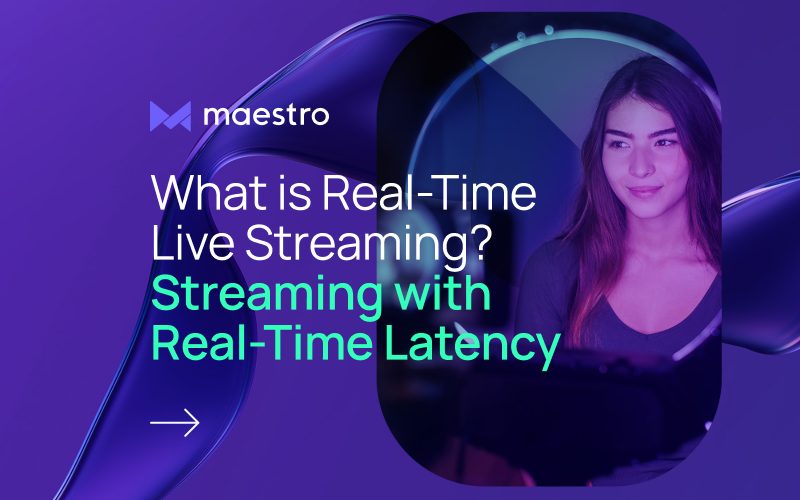What is Real-Time Live Streaming? – Streaming with Real-Time Latency

Real-time live streaming is becoming more and more popular as video production technology evolves to support streams with nearly no latency. As this technology continues to evolve, real-time streaming is becoming more accessible to businesses of any size.
In this article, we will discuss all things real-time live streaming. We’ll start by discussing what real-time live streaming is before we discuss how to achieve real-time latency. From there, we will discuss some real-time live streaming examples.
Table of Contents
- What is Real-Time Live Streaming?
- How to Achieve Real-Time Latency
- Real-Time Streaming Examples
- Real-Time Live Streaming on Maestro
What is Real-Time Live Streaming?

Real-time live streaming is live broadcasting with latency in milliseconds. This means that the video feed reaches the viewers almost as soon as it’s recorded. Similar technology is used for video conferencing on platforms like Google Meets and Zoom.
Streaming with such little latency is valuable for use cases that include audience interactivity and involvement. Since this style of streaming allows viewers to witness events almost as soon as they play out, it creates a more lifelike experience. This almost creates a sense of urgency which captures users' attention and feels more engaging.
Real-Time Latency vs. Ultra-Low Latency vs. Low Latency
It’s important to note that real-time live streaming should not be confused with low-latency or ultra-low-latency streaming. “Low latency” typically describes streams with under five seconds of latency, and “ultra-low latency” describes streams with latency under a second.
Each of these levels of latency is useful in different circumstances. While real-time latency is valuable for those where instantaneous video sharing is necessary, having a little bit of latency is good in some use cases. For example, a talk show could benefit from a little bit of latency to provide room to censor language from guests or hosts that may be inappropriate.
How to Achieve Real-Time Latency
 Achieving real-time live streaming latency requires a streaming setup that fully supports sub-second latency. Specifically, you’ll need an encoder, streaming server, and online video platform that offers this support. You’ll also need a computer with an operating system that supports these more technical elements and a compatible camera.
Achieving real-time live streaming latency requires a streaming setup that fully supports sub-second latency. Specifically, you’ll need an encoder, streaming server, and online video platform that offers this support. You’ll also need a computer with an operating system that supports these more technical elements and a compatible camera.
The way that these technologies achieve real-time latency is with the intentional selection of streaming protocols. A strong and stable internet connection is also typically required for real-time streaming.
With that said, if your goal is to live stream with real-time latency, you need need to get strategic with your setup. As you build your streaming setup, continuously test to ensure that your latency is as low as you’d like it to be.
Protocols for Real-Time Streaming
A few different streaming protocols are used to power real-time live streams, including SRT and WebRTC.
The Secure Reliable Transport (SRT) protocol is an open-source protocol that was designed to reduce latency and adapt to any network condition. Although real-time latency is one of the main goals of SRT, this protocol also maintains high quality in even the slowest internet conditions. SRT is also known for enhanced security.
WebRTC is technically not a protocol but an open-source streaming project. This technology was developed to achieve real-time latency for video conferencing. It is best known for powering early versions of Google Meet.
Both of these streaming technologies have revolutionized the streaming space, making real-time live streaming possible, efficient, and accessible.
Real-Time Streaming Examples
Real-time live streaming is valuable in many use cases. Some specific examples include sporting events, car races, Esports conferences, financial news programs, and auctions.
Streaming with millisecond latency is especially useful where there is betting involved since gamblers can see their bets play out in real time. Real-time live streaming is also valuable for any virtual events that benefit from interactivity.
Some real-time live-streaming brands include the NFL, Prime Video, NASA, and NBC. These specific companies’ real-time live streams are powered by Dolby.io.
Real-Time Live Streaming on Maestro

Thanks to a new partnership, real-time live streaming is now possible on Maestro. This makes our platform a great solution for any brand or creator needing real-time streaming support paired with interactivity and monetization.
Plus, Maestro also includes community management and video analytics. This data is extremely valuable for making informed decisions for your video business.
Interested in giving Maestro a try? Sign up for free to start streaming in no time at all.
Join our Discord server for more helpful tips and tricks!